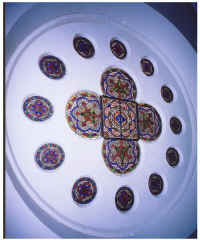Our History
The congregation can be traced back to the inspiring influence of a group of high-minded friends led by Ebenezer Erskine (a minister at Stirling) who seceded from the national church in 1733, calling themselves the Associate Presbytery. In East Fife some like-minded people met in the open air at Balone Den near St Andrews on 2 March 1738 and obtained recognition as a kirk session under this Presbytery. They had no church building of their own at first, and were prepared to walk as far as Ceres or even Abernethy, to hear a minister acceptable to them.
| Photos by
Christine Wolfe |
|
From 1749 onwards the congregation have had meeting places in St Andrews- first in an old barn in Imrie's Close (now 136 South Street) then from 1774 in Burghers' Close (now 141 South Street), from 1827 in a purpose built chapel in North Street (no. 52) then from 1865 in the present building. The name Hope Park was suggested by the then minister the Rev. James Black. For a detailed account of the story of Hope Park Church, from 1738 to 1973, please refer to " The Story of Hope Park Church, St Andrews, A Concise History" by T.T. Fordyce an elder of Hope Park, and Provost of St. Andrews, who donated a sound system to the church in memory of his wife.
Over a period of nearly 250 years, with occasional gaps, this congregation of dissenters from the national church have enjoyed the leadership of a minister of their own. They have been associated with the Burgers group (1747-1820), the United Secession Church (1820-47), the United Presbyterian Church (1847-1900), and the Free Church (1900-29) before accepting union with the Church of Scotland once more in 1929. Until this century these were congregations based on the voluntary principle, which emphasized the desirability of the separation of churches from the state, the need to be financially self-supporting, and comparative freedom to select their own minister.
Today Hope Park is a congregation of the Church of Scotland and is part of the Presbytery of St Andrews. It is Presbyterian but is greatly enriched by having in its congregation, members from other Christian churches and traditions.
| The Church Hall is on the left and the old manse on the
right.
The Church Office is in the basement of the old manse.
Photo by Susan Sinclair |
The congregation had risen to about 300 by the time of the move to the present site, when they erected a building with sittings for 500. The old manse, adjacent to the church, was completed in 1867. The Church Hall was added in 1900. The membership grew to 1100 in the 1980's and two services each Sunday morning have been required to avoid overcrowding. The services have bee designed to satisfy different needs.
From the 1860s the use of a hymn book has extended the range of worship beyond the traditional concentration on psalms and paraphrases. After some years of controversy, (under the dynamic leadership of a new young minister, Dr Sloan, a pipe organ was introduced.
Since then the congregation has kept moving with the times, modernizing the church buildings regularly, in 1987 purchasing a new manse in Priory Gardens so that the minister and his family no longer have to 'live above the shop', from 1970 onwards introducing women elders, and helping with the training of women candidates for the ministry.
The pictures below show some of the stained glass windows in the Church.
